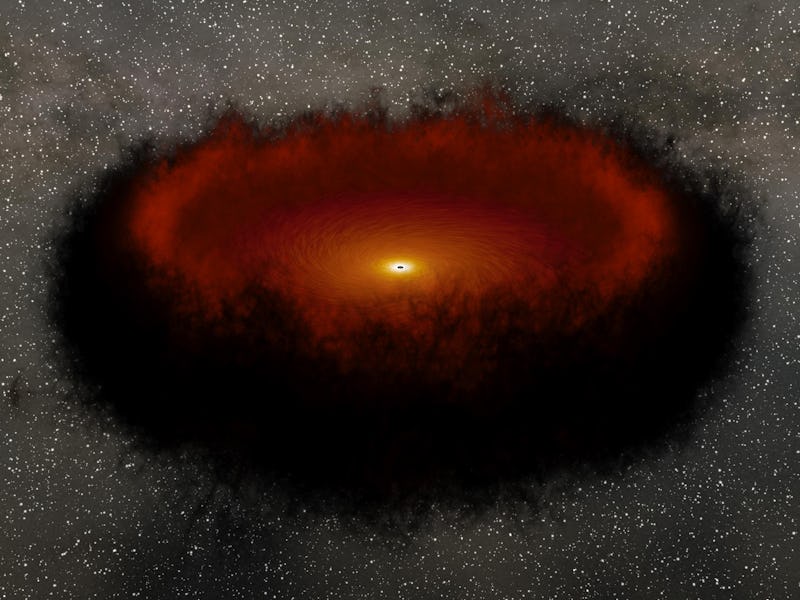One of the strangest objects in space may be key to mapping the cosmos
The echo from a black hole's halo of light could help scientists chart a path through our universe.

Although black holes are dark and mysterious creatures, they are surrounded by light. As these celestial beings pull surrounding matter towards them, it forms a swirling disk of hot gas that shines brightly.
By studying the unusual brightness of a black hole's surrounding disk, astronomers can figure out the distance to the black hole and its host galaxy.
A new study suggests these bright points in the cosmos could ultimately help map out the entire universe.
Using a technique dubbed 'echo mapping,' scientists measured the luminosity of black hole disks in 500 galaxies to gauge their distance from Earth. From there, they created what they say is a preliminary map of the universe at large.
The work is detailed in a study published in the September issue of the Astrophysical Journal.
It's a multi-step process, but it can be broken down into four steps:
- Measure the luminosity of a black hole's disk.
- Compare that measurement to how much brightness the object actually emits.
- Use the information to gauge the distance from Earth to the black hole's host galaxy.
- Finally, create a 3D map of the universe.
Simple.
To measure distances in the universe, scientists compare how much light an object actually emits with how bright it appears in the sky. The difference between those two values reveals how far an object is from Earth based on how long it takes the light to travel to us.
"Measuring cosmic distances is a fundamental challenge in astronomy, so the possibility of having an extra trick up one's sleeve is very exciting," Yue Shen, a researcher at the University of Illinois at Urbana-Champaign and co-author of the new study, said in a statement.
This animation shows the events that serve as the basis of an astrophysics technique called "echo mapping," also known as reverberation mapping.
How do you measure the distance to a black hole? — Black holes are notoriously tricky to study, as not even light can escape these behemoths' gravitational tug. As a result, they are more or less invisible to our eyes. But as a black hole gobbles up surrounding material, it creates a bright, hot disk of swirling gas.
This disk sometimes releases flashes of light that travel away from the black hole. As the light tries to escape the black hole, it bumps into an enormous cloud of dust around the black hole shaped like a donut, called a torus.
When the light flare reaches the inner walls of the dusty cloud, the dust heats up and releases infrared light, or what the scientists refer to as an "echo" of the light released by the disk. For the light to travel between the disk and the torus, which are separated by billions or trillions of miles, it could take several months or even years.
Depending on how long it takes light to travel from the disk to the cloud, scientists can measure the distance between the accretion disk and the torus. Using that information, astronomers can then calculate the luminosity of the disk by looking at its energy output.
The scientists behind the new study say this echo mapping technique can be applied to different galaxies as it does not depend on the size of the black hole at the center of any given galaxy.
But the technique does lack some precision. To improve it, the authors note astrophysicists need to study the structure of the torus cloud, as it could affect the wavelengths of the infrared light being emitted by the dust cloud.
"The beauty of the echo mapping technique is that these supermassive black holes aren't going away anytime soon," Qian Yang, a researcher at the University of Illinois at Urbana-Champaign and lead author of the study, said in a statement.
"So we can measure the dust echoes over and over again for the same system to improve the distance measurement."
Abstract: The size of the dust torus in active galactic nuclei (AGNs) and their high-luminosity counterparts, quasars, can be inferred from the time delay between UV/optical accretion disk continuum variability and the response in the mid-infrared (MIR) torus emission. This dust reverberation mapping (RM) technique has been successfully applied to ∼70 z ≲ 0.3 AGNs and quasars. Here we present first results of our dust RM program for distant quasars covered in the Sloan Digital Sky Survey Stripe 82 region combining ∼20 yr ground-based optical light curves with 10 yr MIR light curves from the WISE satellite. We measure a high-fidelity lag between W1 band (3.4 μm) and g band for 587 quasars over 0.3 ≲ z ≲ 2 ( ⟨z⟩∼0.8⟨z⟩∼0.8 ) and two orders of magnitude in quasar luminosity. They tightly follow (intrinsic scatter ∼0.17 dex in lag) the IR lag-luminosity relation observed for z < 0.3 AGNs, revealing a remarkable size-luminosity relation for the dust torus over more than four decades in AGN luminosity, with little dependence on additional quasar properties such as Eddington ratio and variability amplitude. This study motivates further investigations in the utility of dust RM for cosmology and strongly endorses a compelling science case for the combined 10 yr Vera C. Rubin Observatory Legacy Survey of Space and Time (optical) and 5 yr Nancy Grace Roman Space Telescope 2 μm light curves in a deep survey for low-redshift AGN dust RM with much lower luminosities and shorter, measurable IR lags. The compiled optical and MIR light curves for 7384 quasars in our parent sample are made public with this work.
This article was originally published on